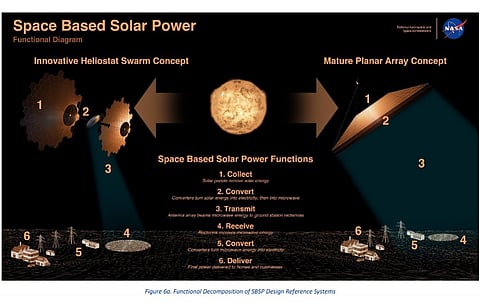

The US National Aeronautics and Space Administration (NASA) believes launching and operating a space-based solar power (SBSP) plant in 2050 will be more expensive than terrestrial sustainable alternatives and generate similar emissions as those on earth.
However, costs can be lowered if current capability gaps can be addressed.
SBSP is a subject of interest not only for the research and scientific community, but also for governments that see it as facilitating solar energy generation in space to be beamed wirelessly back to Earth (see UK Grant Competition For Space-to-Earth R&D).
Remote locations especially can benefit from it. It can also supplement the terrestrial power transmission infrastructure. Nonetheless, its practical feasibility is still being ascertained owing to huge costs.
In a new report, NASA explored the potential benefits, challenges and options for it to engage in growing global interest in SBSP with a focus on what would make SBSP a competitive option to achieve net zero GHG emissions, compared to alternatives.
For this study, it developed a model to calculate the cost and GHG emissions for all aspects of the SBSP reference designs across the full lifecycle of development, assembly, operation, maintenance, delivering 2 GW of power to the electric grid from 2050, and its disposal.
Of the 2 SBSP designs considered, Innovative Heliostat Swarm as representative design 1 (RD1) could generate 99% power through the year with its reflectors concentrating sunlight throughout the day. This leads to a baseline lifecycle cost of electricity (LCOE) of $0.61/kWh with the largest cost driver being the launch of the system, accounting for 71% of RD1. Manufacturing follows next with 22% cost.
Mature Planner Array design or RD2 uses flat panels with solar cells facing away from Earth and microwave emitters facing towards Earth. It generates 60% power through the year as this design cannot reposition itself or redirect solar radiation towards its solar cells.
For RD2, the baseline lifecycle cost of electricity is found to be $1.59/kWh, with launch accounting for 77% of the total cost, followed by 18% manufacturing component.
In general, according to the report, a total of 5 RD2 systems are needed to deliver roughly the same amount of power as a single RD1 system, making the former more expensive. At the same time, RD1 system costs are estimated at $276 billion and RD2 at $434 billion. Yet, RD2 has a higher technology readiness level than RD1.
"We find the SBSP designs are more expensive than terrestrial alternatives and may have lifecycle costs per unit of electricity that are 12-80 times higher," reads the report.
Nonetheless, both are considered to have similar lifecycle GHG emissions intensities to those of terrestrial alternatives. It would need further studies to understand these.
Despite these challenges, NASA believes there is significant potential to drive down the cost and emissions of SBSP systems for which follow-on assessments will need to be conducted.
These solutions include extending hardware lifetime from 10 to 15 years, increasing solar cell efficiency from 35% to 50% (the latter being the highest efficiency of terrestrial research cells tracked by NREL today), bringing down launch costs from $100 million to $50 million, and improving manufacturing learning curves, among others. Increased cell efficiency can bring down LCOE by about 25% for RD1 and 26% for RD2.
The NASA report is available for free viewing on its website.
